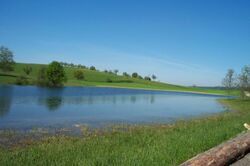Earth:Karst lake

Karst lakes are formed as the result of a collapse of caves, especially in water-soluble rocks such as limestone, gypsum and dolomite. This process is known as karstification. They can cover areas of several 100 square kilometres. Their shallow lakebed is usually an insoluble layer of sediment so that water is impounded, leading to the formation of lakes. Many karst lakes only exist periodically, but return regularly after heavy rainfall.
Distribution
Karst lakes are found in the area around the Harz Mountains of Germany (e. g. the Juessee and the Bauerngraben in the South Harz Karst Landscape Biosphere Reserve, an episodic karst lake on the Karst Trail),[1] in South Germany (e.g. the Eichener See), in France in the region of Quercy, in Estonia the Tudre and the region of Salajõe,[2] in Slovenia (e. g. the Cerkniško jezero), in Ireland the so-called turloughs (there is also a turlough in Wales: Pant-y-llyn near Llandeilo[3]) and some in the United States . Even the cenotes in the north of the Mexican peninsula of Yucatán, which were known by the Mayans, may be classed as karst lakes.
-
The Cenote Sagrado near Chichen Itza is one of the best known karst lakes in Yucatán
-
The Otjikoto Lake in Namibia is a permanent karst lake
See also
References
- ↑ "Biosphärenreservat Karstlandschaft Südharz" (in de-DE). https://nationale-naturlandschaften.de/gebiete/biosphaerenreservat-karstlandschaft-suedharz.
- ↑ "Karstgebiet und Rastplatz Salajõe, Estland" (in de). https://www.visitestonia.com/de/karstgebiet-und-rastplatz-salajoe.
- ↑ "3180 Turloughs : Freshwater habitats". Joint Nature Conservation Committee. https://sac.jncc.gov.uk/habitat/H3180/.
External links


